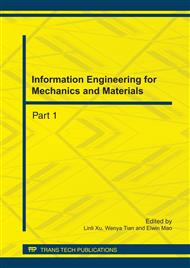[1]
M. Tanabe, N. Matsumoto, H. Wakui, et al. A simple and efficient numerical method for dynamic interaction analysis of a high-speed train and railway structure during an earthquake. J. Comput. Nonlinear Dynam, 2008, 3(4): 1~18.
DOI: 10.1115/1.2960482
Google Scholar
[2]
M Tanabe, H Wakui, M Sogabe, et al. A combined multibody and finite element approach for dynamic interaction analysis of high-speed train and railway structure including post-derailment behavior during an earthquake. IOP Conference Series: Materials Science and Engineering Volume 10 (1): 1-10.
DOI: 10.1088/1757-899x/10/1/012144
Google Scholar
[3]
Y B. Yang, Y S. Wu. Dynamic stability of trains moving over bridge Shaken by earthquake. Journal of Sound and Vibration, 2002, 258, (1, 14 ): 65~94.
DOI: 10.1006/jsvi.2002.5089
Google Scholar
[4]
J.D. Yau, L. Frýba. Response of suspended beams due to moving loads and vertical seismic ground excitations. Engineering Structures, Volume 29, Issue 12, December 2007, Pages 3255-3262.
DOI: 10.1016/j.engstruct.2007.10.001
Google Scholar
[5]
J.D. Yau. Dynamic response analysis of suspended beams subjected to moving vehicles and multiple support excitations. Journal of Sound and Vibration, Volume 325, Issues 4-5, 11 September 2009, Pages 907-922.
DOI: 10.1016/j.jsv.2009.04.013
Google Scholar
[6]
Xiu Luo, Takefumi Miyamoto, Method for running safety assessment of railway vehiclesagainst structural vibration displacement during Earthquakes. Quarterly Report of RTRI, 2007, 48 (3): 129-135.
DOI: 10.2219/rtriqr.48.129
Google Scholar
[7]
Xiu Luo, Takefumi Miyamoto. Examining the Adequacy of the Spectral Intensity Index for Running Safety Assessment of Railway Vehicles during Earthquakes. The 14thWorld Conference on Earthquake Engineering, October 12-17, 2008, Beijing, China.
Google Scholar
[8]
He Xia, Yan Han, Nan Zhang and Weiwei Guo. Dynamic Analysis of train-bridge system subjected to non-uniform seismic excitations. Earthquake Engineering & Structural Dynamics. Volume35, Issue 12, October 2006, Pages: 1563~1579.
DOI: 10.1002/eqe.594
Google Scholar
[9]
X. T. Du, Y. L. Xu and H. Xia. Dynamic Interaction of Bridge-Train System under Non-uniform Seismic Ground Motion. Earthquake Engineering & Structural Dynamics. 2011, 40(5, 25).
DOI: 10.1002/eqe.1122
Google Scholar
[10]
J.H. Lin, D. Kennedy, F.W. Williams An algorithm to study non-stationary random vibrations of vehicle–bridge systems. Computers & Structures, 2009, 87( 3-4): 177-185.
DOI: 10.1016/j.compstruc.2008.10.004
Google Scholar
[11]
Z.C. Zhang, J.H. Lin, Y.H. Zhang, et al. Non-stationary random vibration analysis for train–bridge systems subjected to horizontal earthquakes. Engineering Structures, 2010, 32(11): 3571-3582.
DOI: 10.1016/j.engstruct.2010.08.001
Google Scholar
[12]
Park, R.; and Paulay, T. Use of Interlocking Spirals for Transverse Reinforcement in Bridge Columns. " Strength and Ductility of Concrete Substructures of Bridges, RRU (Road Research Unit) Bulletin 84, Vol. 1, 1990, pp.77-92.
Google Scholar
[13]
Zahn, F.A.; Park, R; and Priestley, M.J.N., Design of Reinforced Bridge Columns for Strength and Ductility, Report 86-7, Department of Civil Engineering, University of Canterbury, Christchurch, New Zealand, March 1986, 330 pages.
Google Scholar
[14]
GB 50011-2001. Code for Seismic Design of Building. Beijing: China Architecture and Building Press, (2008).
Google Scholar
[15]
GB 50111-2006 Code for Seismic Design of Railway Engineering. Beijing: China Planning Press, (2006).
Google Scholar


